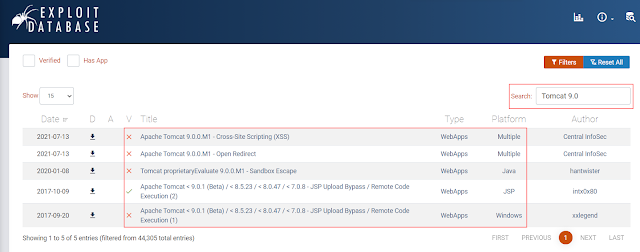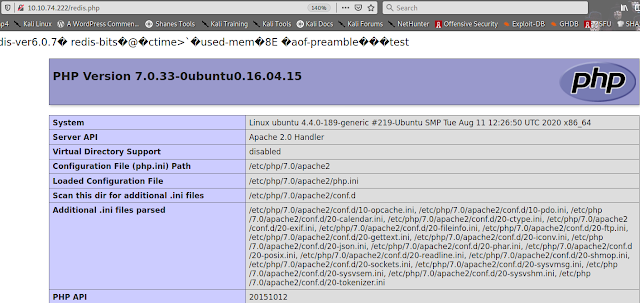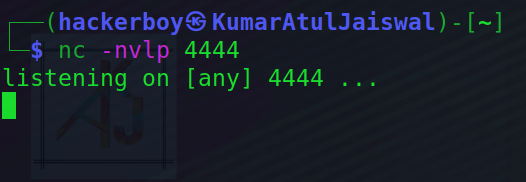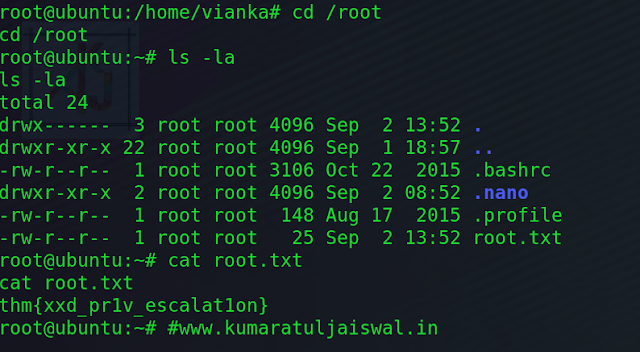Cybersecurity is big business in the
modern-day world. The hacks that we hear about in newspapers are from
exploiting vulnerabilities. In this room, we're going to explain exactly what
a vulnerability is, the types of vulnerabilities and how we can exploit these
for success in our penetration testing endeavours.
An enormous part of penetration testing is
knowing the skills and resources for whatever situation you face. This room is
going to introduce you to some resources that are essential when researching
vulnerabilities, specifically, you are going to be introduced to:
- What vulnerabilities are
- Why they're worthy of learning about
- How are vulnerabilities rated
- Databases for vulnerability research
- A showcase of how vulnerability research is used on ACKme's engagement
Introduction to Vulnerabilities
A vulnerability in cybersecurity is defined as a weakness
or flaw in the design, implementation or behaviours of a system or
application. An attacker can exploit these weaknesses to gain access to
unauthorised information or perform unauthorised actions. The term
“vulnerability” has many definitions by cybersecurity bodies.
However, there is minimal variation between them all.
For example,
NIST defines a vulnerability as “weakness in an information system, system
security procedures, internal controls, or implementation that could be
exploited or triggered by a threat source”.
Vulnerabilities can
originate from many factors, including a poor design of an application or an
oversight of the intended actions from a user.
We will come on to
discuss the various types of vulnerabilities in a later room. However, for
now, we should know that there are arguably five main categories of
vulnerabilities:
| Vulnerability | Description |
|---|---|
| Operating System | These types of vulnerabilities are found within Operating Systems (OSs) and often result in privilege escalation. |
| (Mis)Configuration-based | These types of vulnerability stem from an incorrectly configured application or service. For example, a website exposing customer details. |
| Weak or Default Credentials | Applications and services that have an element of authentication will come with default credentials when installed. For example, an administrator dashboard may have the username and password of "admin". These are easy to guess by an attacker. |
| Application Logic | These vulnerabilities are a result of poorly designed applications. For example, poorly implemented authentication mechanisms that may result in an attacker being able to impersonate a user. |
| Human-Factor | Human-Factor vulnerabilities are vulnerabilities that leverage human behaviour. For example, phishing emails are designed to trick humans into believing they are legitimate. |
1) An attacker has been able to upgrade the permissions of their
system account from "user" to "administrator". What type of vulnerability is
this?
Ans- Operating System
2) You manage to bypass a login panel using cookies to authenticate. What
type of vulnerability is this?
Ans- Application logic
Scoring Vulnerabilities (CVSS & VPR)
Vulnerability management is the process of evaluating,
categorising and ultimately remediating threats (vulnerabilities) faced by an
organisation.
It is arguably impossible to patch and remedy every
single vulnerability in a network or computer system and sometimes a waste of
resources.
After all, only approximately 2% of vulnerabilities only
ever end up being exploited (Kenna security., 2020). Instead, it is all about
addressing the most dangerous vulnerabilities and reducing the likelihood of
an attack vector being used to exploit a system.
This is where
vulnerability scoring comes into play. Vulnerability scoring serves a vital
role in vulnerability management and is used to determine the potential risk
and impact a vulnerability may have on a network or computer system. For
example, the popular Common Vulnerability Scoring System (CVSS) awards points
to a vulnerability based upon its features, availability, and
reproducibility.
Of course, as always in the world of IT,
there is never just one framework or proposed idea. Let’s explore two of the
more common frameworks and analyse how they differ.
Common Vulnerability Scoring System
First introduced in 2005, the Common Vulnerability Scoring System (or
CVSS) is a very popular framework for vulnerability scoring and has three
major iterations. As it stands, the current version is CVSSv3.1 (with version
4.0 currently in draft) a score is essentially determined by some of the
following factors (but many more):
1.
How easy is it to exploit the vulnerability?
2.
Do exploits exist for this?
3.
How does this vulnerability interfere with the CIA triad?
In fact, there are so many variables that you have to
use a calculator to figure out the score using this framework. A vulnerability
is given a classification (out of five) depending on the score that is has
been assigned. I have put the Qualitative Severity Rating Scale and their
score ranges into the table below.
| Rating | Score |
|---|---|
| None | 0 |
| Low | 0.1-3.9 |
| Medium | 4.0-6.9 |
| High | 7.0-8.9 |
| Critical | 9.0-10.0 |
However, CVSS is not a magic bullet. Let's analyse some of the
advantages and disadvantages of CVSS in the table below:
| Advantages of CVSS | Disadvantages of CVSS |
|---|---|
| CVSS has been around for a long time. | CVSS was never designed to help prioritise vulnerabilities, instead, just assign a value of severity. |
| CVSS is popular in organisations. | CVSS heavily assesses vulnerabilities on an exploit being available. However, only 20% of all vulnerabilities have an exploit available (Tenable., 2020) . |
| CVSS is a free framework to adopt and recommended by organisations such as NIST. | Vulnerabilities rarely change scoring after assessment despite the fact that new developments such as exploits may be found. |
Vulnerability Priority Rating (VPR)
The VPR framework is a much more modern framework in
vulnerability management - developed by Tenable, an industry solutions
provider for vulnerability management. This framework is considered to be
risk-driven; meaning that vulnerabilities are given a score with a heavy focus
on the risk a vulnerability poses to the organisation itself, rather than
factors such as impact (like with CVSS).
Unlike CVSS, VPR scoring takes into account the relevancy of a
vulnerability. For example, no risk is considered regarding a vulnerability if
that vulnerability does not apply to the organisation (i.e. they do not use
the software that is vulnerable). VPR is also considerably dynamic in its
scoring, where the risk that a vulnerability may pose can change almost daily
as it ages.
VPR uses a similar scoring range as CVSS, which I have
also put into the table below. However, two notable differences are that VPR
does not have a "None/Informational" category, and because VPR uses a
different scoring method, the same vulnerability will have a different score
using VPR than when using CVSS
| Rating | Score |
|---|---|
| None | 0 |
| Low | 0.1-3.9 |
| Medium | 4.0-6.9 |
| High | 7.0-8.9 |
| Critical | 9.0-10.0 |
Let's recap some of the advantages and disadvantages of
using the VPR framework in the table below.
| Advantages of VPR | Disadvantages of VPR |
|---|---|
| VPR is a modern framework that is real-world. | VPR is not open-source like some other vulnerability management frameworks. |
| VPR considers over 150 factors when calculating risk. | VPR can only be adopted apart of a commercial platform. |
| VPR is risk-driven and used by organisations to help prioritise patching vulnerabilities. | VPR does not consider the CIA triad to the extent that CVSS does; meaning that risk to the confidentiality, integrity and availability of data does not play a large factor in scoring vulnerabilities when using VPR. |
| Scorings are not final and are very dynamic, meaning the priority a vulnerability should be given can change as the vulnerability ages. | Intentionally left blank. |
1) What year was the first iteration of CVSS published?
Ans- 2005
2) If you wanted to assess vulnerability based on the risk it poses to an
organisation, what framework would you use?
Note: We are looking for the acronym here.
Ans- VPR
3) If you wanted to use a framework that was free and open-source, what
framework would that be?
Note: We are looking for the acronym here.
Ans- CVSS
Vulnerability Databases
Throughout your journey in cybersecurity, you will often come across a
magnitude of different applications and services. For example, a
CMS whilst they all have the same purpose, often have very
different designs and behaviours (and, in turn, potentially different
vulnerabilities).
Thankfully for us, there are resources on the
internet that keep track of vulnerabilities for all sorts of software,
operating systems and more! This room will showcase two databases that we can
use to look up existing vulnerabilities for applications discovered in our
infosec journey, specifically the following websites:
1.
NVD (National Vulnerability Database)
2.
Exploit-DB
Before we dive into these two resources, let's ensure that our understanding of some fundamental key terms is on the same page:
| Term | Definition |
|---|---|
| Vulnerability | A vulnerability is defined as a weakness or flaw in the design, implementation or behaviours of a system or application. |
| Exploit | An exploit is something such as an action or behaviour that utilises a vulnerability on a system or application. |
| Proof of Concept (PoC) | A PoC is a technique or tool that often demonstrates the exploitation of a vulnerability. |
While this website helps keep track of new vulnerabilities, it is
not great when searching for vulnerabilities for a specific application or
scenario.
Exploit-DB
Exploit-DB is a resource that we, as hackers, will find much more
helpful during an assessment. Exploit-DB retains exploits for software and
applications stored under the name, author and version of the software or
application.
We can use Exploit-DB to look for snippets of code
(known as Proof of Concepts) that are used to exploit a specific
vulnerability.
1) Using NVD, how many CVEs were submitted in July 2021?
Ans -
2) Who is the author of Exploit-DB?
Ans -
An Example of Finding a Vulnerability
In this task, I’m going to demonstrate the process of finding one minor
vulnerability, coupled with some research of the vulnerability databases
leading to a much more valuable vulnerability and exploit ultimately.
Throughout
an assessment, you will often combine multiple vulnerabilities to get results.
For example, in this task, we will leverage the “Version Disclosure”
vulnerability to find out the version of an application. With this version, we
can then use Exploit-DB to search for any exploits that work with that
specific version.
Applications and software usually have a version
number. This information is usually left with good intentions; for example,
the author can support multiple versions of the software and the likes. Or
sometimes, left unintentionally.
For example, in the screenshot
below, we can see that the name and version number of this application is
“Apache Tomcat 9.0.17”
With this information in hand, let’s use the search filter on Exploit-DB
to look for any exploits that may apply to “Apache Tomcat 9.0.17”.TryHackMe Vulnerability 101
Great! After searching Exploit-DB, there are a total of five
exploits that may be useful to us for this specific version of the
application.
1) What type of vulnerability did we use to find the name and version of
the application in this example?
Ans-
Disclaimer
All tutorials are for informational and educational purposes only and have
been made using our own routers, servers, websites and other vulnerable free
resources. we do not contain any illegal activity. We believe that ethical
hacking, information security and cyber security should be familiar subjects
to anyone using digital information and computers.
Hacking Truth is
against misuse of the information and we strongly suggest against it. Please
regard the word hacking as ethical hacking or penetration testing every time
this word is used. We do not promote, encourage, support or excite any illegal
activity or hacking.
- Hacking Truth by Kumar
Atul Jaiswal





































































